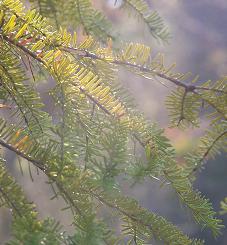NEW MARKET, Va. — If you're dreaming of a green Christmas, you can start with a living Christmas tree.
Haul it home, decorate it, stack presents beneath it, celebrate around it and then - rather than drag it to the curb with the discarded wrapping paper - place it into a hole in the yard and enjoy it as part of the landscape for many holidays to come.
Living Christmas trees made up a very small percentage of the 28.6 million real trees sold last year, said Rick Dungey, public relations manager for the National Christmas Tree Association in Chesterfield, Missouri Although the group doesn't keep specific data on living trees, Dungey said the trees are more popular in warm areas, where they seem to survive better.
The relatively few nursery operators who sell live trees generally market them "b&b" (with the roots balled and burlapped) or in pots, Dungey said.
"Containerized trees are grown in tubs sunk into the ground on the Christmas tree farms. Rather than get a mechanical digger and excavate a big root ball, they just haul up the container," he said. "Balled-and-burlapped varieties have a bit better survivability but they're bulky and a real load to handle."
Steve Mannhard, owner of Fish River Trees, a 45-acre choose-and-cut operation near Summerdale, Alabama, says he gets a lot of repeat business for living trees from customers who plant them in their yard or donate them to churches, schools or neighbors. Live Christmas trees are cleaner and safer than the precut varieties when watered properly, he said.
"They will eliminate a lot of the mess or the needle drop you have with cut trees. People will tolerate that but they're not crazy about it," he says. "And the greenery on a living tree won't burn. It's like putting lights on an outdoor tree."
Living trees cost about as much as the precut versions if customers are willing to drive to Mannhard's farm to pick them up. Prices for the balled and burlapped varieties are similar.
"White pines sell here for $50 to $60," said David Daniken, owner of Daniken Tree Farms in Pocahontas, Illinois "Norway spruce go for $70 to $75."
Mannhard said his customers are planting the trees together as a post-Christmas family event.
"Children are getting trees named after them. That will be a strong emotional tug for those children after they grow up to go back and look at that tree and remember when their parents, grandparents and themselves put it there," he said.
And the symbolism can hit home as soon as Easter: "When a tree is planted after the holidays and it begins to grow again in the spring, it becomes a symbol of rebirth."
Plan well ahead if you intend to bring a living Christmas tree indoors:
--Find a suitable post-holiday planting site, one capable of supporting a tree that can grow 40- to 60-feet high. Dig your hole before the ground freezes rock hard and then mulch it heavily to keep the area from refreezing.
--Choose only native trees that can survive the indoor-outdoor handling and that fit readily into your yard. "Fraser firs are a popular Christmas tree in the East," said George Kessler, an extension forester and assistant professor at Clemson University in Clemson, South Carolina "A lot of people will plant them in areas where they have no business being. ... Just because someone is selling them locally doesn't mean they will grow there," he said. "Get a native tree or one that's proven to grow in your area."
--Don't over-water. "One of the biggest problems people have with living Christmas trees is over-watering while they have them inside," Kessler said. "That's easy to overcome. Put a hollow tube down into the container the tree is in and use that for watering. You don't have to water a living tree as often as a cut tree. You'll drown it if you leave it in standing water."
--Give the tree some time to readjust when you take it outside after the holidays. "You must transition the tree when taking it from indoor, 72-degree temperatures back into the cold," Kessler said. "Keep it in a garage or porch out of the wind for a few days but plant as soon as you can. Don't wait until spring. Water it until the site is ready."
--Be prepared to nurture a living Christmas tree at least two years, especially in drought-stricken regions like the Southeast, Kessler said. "The first year is always critical on water. The root system is wrapped in a ball and is out of proportion with the size of the tree that you have. That continues even into the second year. Regular watering is important until the tree is established."
You can contact Dean Fosdick at deanfosdick(at)netscape.net.
http://www.wral.com/lifestyles/house_and_home/story/2032304/

















No comments:
Post a Comment